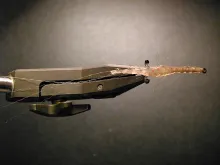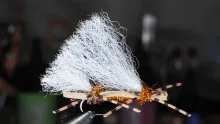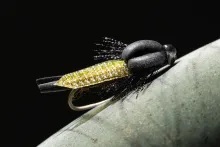A bunch of quite realistic flies by a bunch of well known and unknown international tiers. These fantastic flies are not super realistic imitations, but they certainly look real and convincing enough to fool both men and fish!
Some people tie flies that look so real that you expect them to start crawling as soon as they are released from the vice. Steve Thornton who was recently featured here on Global FlyFisher is one, and Bob Mead - of praying mantis fame - is another.
Others tie flies, which are realistic imitations, but not quite to that extent. Many of these flies are meant to be fished, but still look so real that they will fool people as well as fish.
This article feature a few patterns of the both types, tied by fly tiers from the whole world.
These flies are not super realistic imitations, but they certainly look real enough!
What's realistic?
I have seen some extremely precise copies of natural insects in my time. The only visible difference between the natural and the fly has been a hook eye in the front (or rear) and that telltale point and barb in the other.
Apart from that these flies have been so exact replicas, that even hairs on the legs and joints on the antennae have been present. Dutch Nathan Drohm once displayed a hatching stonefly on a Dutch Fly Fair that stunned everybody. The fly combined a tied adult emerging from a real shuck. It was almost impossible to see the tied parts from the shuck that Nathan had probably picked up by some stream.
At a fly show some years ago Bob Mead told me that he ties the legs for his famous praying mantis one at a time, and that a single leg can take a whole day to tie! The final result is a complete, very large and very lifelike replica of a mantis. It does have a hook in it, even though that is not obvious until you have looked very close. At the same show Bob was cranking out mosquitoes tied reverse on a small hook, cleverly disguising the hook point as the proboscis of the fly. You can see an example of this mosquito here on this page, and no doubt... it is extremely realistic!
|
|
|
|
|
|
Impression vs. naturalism
There are less extreme ways of mimicking nature. Two of the shrimps featured in this article are good examples of some approaches.
They are tied by French Jean Pierre Lagathu and Dutch Jan Reniers respectively and the two tiers use two different approaches, Jean Pierre's use of epoxy for molding a very lifelike body making one of the major differences.
Jan's way of depicting a shrimp is more impressionistic and simple without being crude. He uses few materials and his pattern does not try to imitate the natural exactly, but rather hints the look and features of a shrimp or a small crayfish. Jan's fly incorporates his trademark material, eel-skin, as do many of his other patterns.
Jean Pierre's fly is on the other hand a very exact copy of a real shrimp. Most shrimp patterns lack the characteristic hump on the back of the animal, and the transparency of Jean Pierre's fly. Combined with the rib on the shield and the egg sack on its underside, it makes the finished fly come out very close to the natural.
But the oversize eyes and the tufts of hair portraying the antennae and the tail brings the fly back on the impressionistic level. These parts are not far from the natural, but not exact copies either. They produce the perfect impression of a shrimp in combination with the body.
Jan's small scud pattern uses the same means as his shrimp - including the eel skin - to imitate a small gammarid scud or cress bug. We see again the exaggerated eyes, legs and antennae, but are again left with the impression of something very lifelike.
Hot melt glue
Swedish Per Måhrd tied his hot melt glue shrimp for me during a fly show here in Denmark. He basically used glue and monofilament nylon and nothing else.
The trick to shaping the body was to let the glue cool down and almost set, while Per controlled it with a tying thread. Glue that sets too fast was quickly remelted with a lighter. This way the glue could be distributed over the body to get the right profile, and the segmented effect was obtained by ribbing the tying thread into the glue when it was almost set.
No one can say that this is an exact imitation, but yet it looks a lot like the real thing. At the same time it is an easy tie with enough trades of the real thing to fool a fish. A few marks with waterproof colors puts the icing on the cake, and you have a durable, lifelike fishing fly.
Deadlike imitation
If imitating a live animal offers a problem, why not go for the dead one? Most fish do not really care whether their food is dead or alive, particularly those taking insects on the surface. Spinners are a prime example of fish scavenging on dead insects, but many of us have seen fish rise to the odd spider or (formerly) flying insect floating downstream all curled up and messy in an agonizing posture of death.
Imitating the curled legs and worn wings is a lot easier than trying to copy the right position of the live animal's appendages.
Even the animal's position on the water can be ignored. While most live animals will ride legs down and wings up - if any are present - the dead ones will mostly just fall on their side or float in whatever position they might have wound up.
British Oliver Edwards have utilized some these facts in a simple, almost generic pattern that imitates a dead or almost dead insect. The POPA caddis or Post OviPositing Adult from Oliver's book Fly Tyers Masterclass is an imitation of a caddis that has laid its eggs and is about to die or - in a few cases - fly off the water to mate again. Caddises often break the surface to lay eggs, and upon reemerging they are trapped in the surface film for some time, either lifeless or feebly fluttering to escape.
Olivers' fly catches this stage with a simple pattern bearing all the hallmarks of the natural: wings, legs and antennae, but not exactly imitating the natural 100 percent.
The legs made from curled, chopped deer hair and the raffeee or Swiss straw wings are perfect examples of how to obtain the desired imitative effect using simple materials.
Yellow Sally and Darth Vader
Chuck Echer and Juro Mukai have tied each a stonefly. The two patterns are as far apart as they can come on the scale. Whether we look at the animals they imitate, the tying style of the fly or the durability and purpose, they represent each their part of the specter.
Chuck's fly is small and delicate, and tied with museum grade precision. It is a small adult Yellow Sally type stonefly, made with a beautiful feather wing and very high focus on symmetry and dimensions. It leaves an impression very close to the natural, but then again does not look the least like a real stonefly once you look closer. The hackle representing the legs is a typical fingerprint of impression versus realism. The real stonefly has six large and very distinctive legs.
Juro's fly is a lot rougher in its style, lacks the symmetry and delicacy of its smaller counterpart. But in spite of this it is actually closer to the natural, a large black stonefly nymph. Asymmetry and a tangle of very realistic legs will probably make it a great catcher of fish, very closely imitating a dead stonefly tumbling down a riverbed. You can of course arrange the legs to perfectly imitate a stonefly, but my guess is that it is not worth the bother.
The pitch-black appearance accentuated by the raffene wing buds, the obvious segments on the abdomen and the hairy legs and thorax, makes this fly a somewhat scary Darth Vader of flies.
|
|
|
|
|
|
Ants and mosquitoes
My own foam ant is simplicity itself, but obviously attains what I have striven for: to imitate a natural ant. The pattern is Oliver Edwards' - one of the fathers of tying close-to-natural flies. Foam and bristles from a broom is all it takes. I used a book on insects to get the legs and antennae perfect, which is a key element in making the ant appear real. The fly is easy and quick to tie, and even catches fish! The same method can be used for other types of black-legged insects, namely beetles.
Bob Mead's mosquito - as mentioned in the introduction - is not exactly another fast tie. It might seem so to Bob himself, compared to some of his other patterns, but these are not flies that are cranked out by the dozen in an hour.
The pattern is extremely lifelike. The brilliant move is the reversing of the fly on the hook, which cleverly integrates the hook point in the pattern as part of the proboscis of the natural.
The legs are a study in themselves, carefully crafted from feather stems, trimmed and bent to shape. The wings and thorax of the fly are made from carefully selected feathers and the striped abdomen is delicately tufted with short hair, so real that it amazes.
Bob Mead is an artist within his field, and flies like his are not for all of us to tie. But as the patterns on this page has shown, less than his skills can do to tie flies that are real enough.
- Log in to post comments

































Can someone help me
Can someone help me I am looking for Lucky Ladybug Fly by Bob Mead, for my dad
Thank you
Carol
This is one of the b
This is one of the best misquito patterns i have seen on the net. may i please have the pattern and instructions for tying this fly? Thank you, jeanne
i have not yet reall
i have not yet really tried fishing but reading this article makes me want to head to the nearest sea just to try few of the many that you have suggested.
Hey Martin -
Hop
Hey Martin -
Hope you are well. I have linked my recipe for this stonefly to your pic rather than post a copy, and included credits to you for the photo. FYI
I hope you fish that fly - it has been good to me!
I find the Lagathu's
I find the Lagathu's Shrimp very realistic and would like to know how to tie it. Can you please email me directions, or direct me to the site that offers detailed tying instructions. Thank, you Al
does a pattern list exist ?
i was just wondering if there are any videos or step by step instructions on how to tie the Lagathu's shrimp fly ? I found lots of pics on the global fly fisher site just cant seem to find a how to make section any help on this would be very helpful thank you
No step-by-step exists
James,
The shrimp fly was submitted for an article many, many years ago, and there was only this one finished fly and no other information: no materials, no description, no step-by-step.
The only way to get it tied is probably to arm yourself with some LCR (Lagathu very likely used epoxy), some mono eyes, a bit of hair and dubbing, rib etc. and start experimenting.
Martin